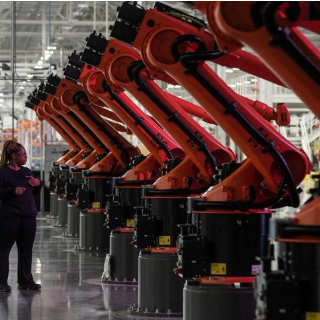


U.S. factory activity slowed to a four-month low in November as higher prices because of tariffs on imports restrained demand, leading to a piling up of unsold goods that could hinder growth in the overall economy.
Relief for manufacturers is unlikely to come soon as the University of Michigan's Surveys of Consumers separately showed on Friday a sharp drop in buying conditions for long-lasting manufactured goods. The University of Michigan noted that "consumers remain frustrated about the persistence of high prices and weakening incomes."
President Donald Trump's sweeping import duties have raised prices, straining household budgets, especially for lower- and middle-income consumers. A robust stock market boosted spending for higher-income households, creating what economists called a K-shaped economy. But a recent sell-off has hurt confidence among wealthy Americans, and could restrain their spending.
"What's going to happen is that people at the low end of the income spectrum will probably not spend very much," said Sung Won Sohn, a finance and economics professor at Loyola Marymount University. "And given the uncertainty in the stock market, this is going to hurt even the spending of wealthier people, especially retirees."
S&P Global said its flash U.S. manufacturing PMI slipped to 51.9 this month from 52.5 in October. A reading above 50 indicates growth in the manufacturing sector, which accounts for 10.2% of the economy. Trump has defended his protectionist trade policy as necessary to help revive the manufacturing industry.
Economists polled by Reuters had forecast the manufacturing PMI at 52.0. The survey's measure of new orders received by factories dropped to 51.3 from 54.0 in October, while inventory was the highest in the survey's history.
"Manufacturers reported a worrying combination of slower new orders growth and a record rise in finished goods stock," said Chris Williamson, chief business economist at S&P Global Market Intelligence. "This accumulation of unsold inventory hints at slower factory production expansion in the coming months unless demand revives, which could in turn feed through to lower growth in many service industries."
There is no spillover yet as business activity picked up again this month. The U.S. Composite PMI Output Index, which tracks the manufacturing and services sectors, increased to 54.8 from 54.6 in October.
SERVICES SECTOR IS HOLDING UP
Services businesses offset the slowdown in manufacturing, with the PMI climbing to 55.0 from 54.8 last month.
The survey's measure of new orders received by businesses increased to 55.0 from 53.6 last month. S&P Global noted a marked improvement in confidence in the year ahead, which it attributed to expectations for more interest rate cuts, the end of a 43-day shutdown of the government as well as "reduced worries over the political environment and hopes for increased policy support to business."
The survey was conducted from November 12 to November 20. Democrats swept a trio of races on November 4 in the first major elections since Trump regained the presidency. The off-year elections and end of the longest shutdown in history likely contributed to a slight improvement in consumer sentiment from earlier this month.
Source: Investing.com
President Donald Trump's tariff increases on imports from foreign countries will reduce U.S. deficits by $3 trillion if they are maintained through 2035, the non-partisan Congressional Budget Office e...
US job growth accelerated in September and the unemployment rate rose slightly, suggesting the labor market was showing signs of stabilization before the government shutdown. Nonfarm payrolls increas...
Initial jobless claims in the United States reached 232,000 for the week ending October 18, according to data from the US Department of Labor website. This represents a slight increase compared to the...
The global geopolitical situation is once again showing signs of escalation, particularly in the Asia-Pacific region. A ship collision between the Chinese Coast Guard and the People's Liberation Army ...
Most big emerging economies, including China, Brazil and India, can weather U.S. tariffs without excessive pain, a study by risk consultancy Verisk Maplecroft showed, raising doubt about the clout of ...
The Dow Jones Industrial Average rebounded on Friday after New York Federal Reserve President John Williams suggested the central bank could cut interest rates yet again this year. The blue-chip index gained 529 points, or 1.2%. The Nasdaq...
EUR/USD posts moderate losses during the North American session on Friday as the US Dollar (USD) holds firm after the release of mixed economic data and dovish comments by Federal Reserve (Fed) officials. The pair trades at 1.1504, down 0.20%,...
U.S. factory activity slowed to a four-month low in November as higher prices because of tariffs on imports restrained demand, leading to a piling up of unsold goods that could hinder growth in the overall economy. Relief for manufacturers is...
 A divided Federal Reserve cut interest rates last month even as many policymakers cautioned that lowering borrowing costs further could risk...
A divided Federal Reserve cut interest rates last month even as many policymakers cautioned that lowering borrowing costs further could risk...
 US stocks finished higher on a volatile Wednesday session, reversing some of the sharp selling from the prior four sessions as markets digested a...
US stocks finished higher on a volatile Wednesday session, reversing some of the sharp selling from the prior four sessions as markets digested a...
 Asian chip stocks opened higher on Thursday after Nvidia reported better-than-expected results and provided a highly optimistic outlook, reinforcing...
Asian chip stocks opened higher on Thursday after Nvidia reported better-than-expected results and provided a highly optimistic outlook, reinforcing...
 The Minutes of the United States (US) Federal Reserve's (Fed) October 28-29 monetary policy meeting will be published on Wednesday at 19:00 GMT. The...
The Minutes of the United States (US) Federal Reserve's (Fed) October 28-29 monetary policy meeting will be published on Wednesday at 19:00 GMT. The...